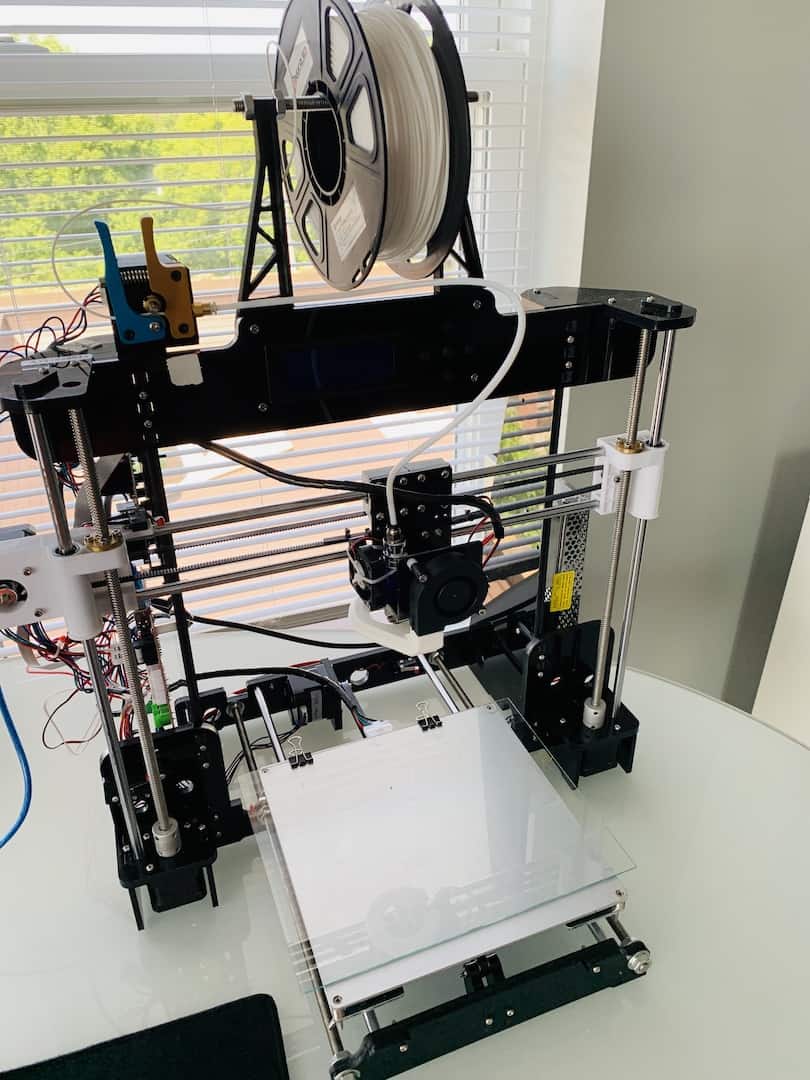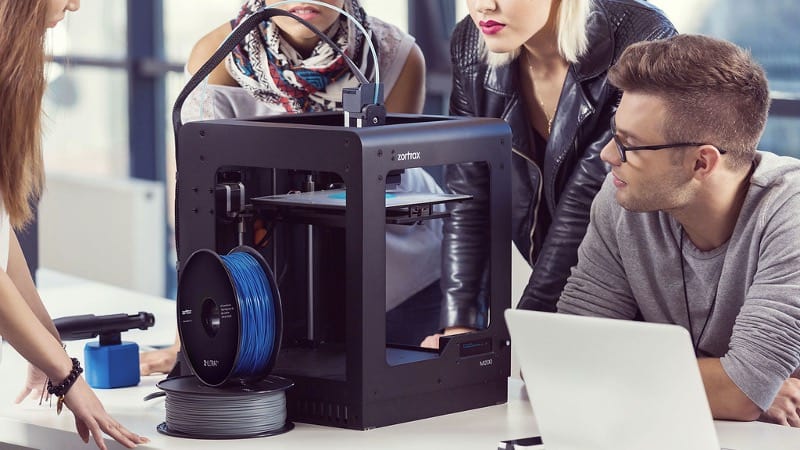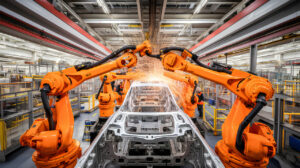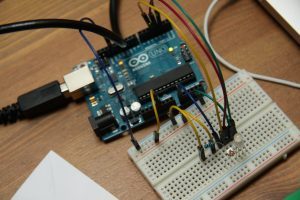You probably landed on this article because you A) need to buy a 3D printer, B) want to get into 3D printing, and C) aren’t sure what the best option is. You are probably skeptical that you should spend more than $500 on a 3D printer because many options under $200 seem like a better deal.
And, while I think 3D printer kits have their place, this article is going to focus more on buying 3D printers over $500 to manufacture parts. That means you want a 3D printer that can work reliably and on-demand to fulfill 3D print jobs.
So, if you’re looking for your next 3D printer to build, I recommend skipping this article and checking out my guide on 3D printing with an Anet A8.
And, for the record, I’m not against buying a 3D printer kit.
Having an Anet A8 taught me everything about 3D printing, from setup to manufacturing best-practices. A lot of these skills you won’t learn with a high-quality 3D printer. Things like bed leveling, bed adhesion, and nozzle assembly have already been engineered into the product.
However, if you’re looking for a 3D printer to 3D print things—one that’s reliable, easy-to-use, and can handle higher volumes, consistently—then you’ll want to continue reading.
Why Spending over $500 on a 3D Printer is a Good Idea
There are many reasons why you shouldn’t buy a “cheap” 3D printer. In this section, I’m focusing mostly on the 3D printer kits you can purchase under $250. Popular choices are the Anet A8 and Creality Ender 3 to name a few.
And while both of these options can be phenomenal choices, generally, they’re a PITA to set up, calibrate, and use consistently. My first 3D printer was an Anet A8, and I’ve used the Creality Ender 3 in industry jobs a few times.

And I know a lot of people who have great luck with the Creality Ender 3. If you’re thinking about a 3D printer kit, I’d err on the side of getting that versus a full Prusa Clone (like the Anet A8).
[amazon box=”B07GYRQVYV” template=”list”]While the actual printer is very cheap, you’re going to spend a lot of time building, calibrating, and troubleshooting the printer.
This amounts to a lot of wasted time that you could be spending doing other (value-add) tasks.
Rather than doing the magic dance hoping that your bed is level, your nozzle won’t leak, and that the part will have good bed adhesion, you can focus on sending the print and letting a quality 3D printer do its job.
And trust me, if you have any 3D printing experience, getting a quality print, consistently, is half the battle.
1. Easy & Fool-Proof Setup
One of the best parts about buying a 3D printer over $500 is that setup is a BREEZE.
Literally, like sitting on a private island. Sun shining. Drink in hand. Lather up that sunscreen.
But, actually.
A lot of 3D printer kits require manual leveling, filament loading, nozzle assembly, and monitoring. When you spend a little more on a printer, you’ll get so many more priceless features.
And, while you might think that you’re handy enough to perform these manual processes, nothing beats automatic modes.
Automatic bed leveling, preheating, and filament loading are truly a game-changer. You can be the best at any of these steps manually, but the automatic mode will have you beat each time.
[amazon box=”B07JVB5LH1″ template=”list”]Additionally, if you’re using this 3D printer in a public space: classroom, coworking space, makerspace, office, college lab, etc. then, you’re going to want to make setting up prints as easy as possible.
You don’t want your lab manager struggling to get filament loaded into the nozzle. You won’t want your coworkers messing with the bed set-screws.
Having these features built-in will not only help the user, but it’ll also preserve the printer for thousands of hours of quality printing (that I’m sure you’re hoping to do).
Buy a more expensive 3D printer if you don’t want to go through the tedious processes that come with 3D printing.
2. 3D Printers over $500 Offer Reliability & Consistency
Secondly, reliability and consistency are important when it comes to 3D printing. For most 3D printers over $500, you’ll be able to get started printing right away with minimal setup or intervention.
This isn’t something you’re going to get immediately with a 3D printer kit. You’ll either have to spend a lot of time tuning the printer to achieve the same reliability, or you’ll have to settle with the uncertainty of not knowing how your parts are going to come out.
Additionally, when you spend more than $500 on a 3D printer, you’re getting a machine that is “set and forget.”
Once you run the print, and the first layer looks good, you can pretty much let the printer run the job until it’s finished. Jobs that are over ten hours won’t be ruined in hour three.
Printers in the $500+ range tend to have better performance to complete a higher percentage of quality jobs.
Buy a 3D printer over $500 if you want to focus on 3D printing parts and not fixing, troubleshooting, and tuning your 3D printer.
3. Saves You Time and Money Later
A lot of the 3D printer kits come with cheap, lower-quality components. That means you’ll be spending extra money upgrading or replacing bearings, bent axle rods, burnt boards, and more.
This is fine if you’re up for the maintenance and repair work that comes with a 3D printer hobby kit.
However, for most people looking to print 3D parts, you’re going to want a machine that can handle daily prints without breaking, dying, or igniting. (Yep, I’ve seen first-hand a 3D printer kit go up in flames.)
If you don’t want to spend at least $200+ in time, money, and spare parts, maintenance, and upgraded components, then you might as well buy a quality 3D printer from the start.
Invest in a 3D printer over $500 if you don’t want to be constantly wasting time on repairs and upgrades and spending money on spares and replacement parts.
4. 3D Printing is More Enjoyable
Buying a nicer 3D printer from the start will make the 3D printing process more efficient and enjoyable.
You won’t be frustrated when your parts get ruined by leaky filament.
You won’t want to smash your 3D printer kit with a hammer when the part detaches from the bed, mid-print.
You won’t hate 3D printing because it’s so difficult.
Instead, you can focus on the process of setting up a print, running the G-code, and manufacturing something cool.
The purpose of buying a 3D printer is to make parts. (Imagine that!)
So spend less time trying to build a 3D printer and more time making that widget you’ve designed. That alone should be worth the additional upfront investment.
Best 3D Printers to Buy Based on Price Range
While we have a whole article dedicated to which 3D printers are worth buying, I wanted to provide a bunch of “more premium” options in case you’re looking for a 3D printer today.
Rather than scour the internet looking for different options by price, you can use this list as a guide. Here are twelve different options based on three price-points.
[amazon box=”B07V2LM2H6,B07X7LQWQK,B07PGZNM34″ template=”list”]3D Printers for $500-$1000
You can find quality 3D printers in the $500-$1000 range. I recommend the FlashForge Adventurer 3 (which is what I have), as well as the Dremel Digilab 3D20, Creality 3D Printer CR-10S Pro, and the FlashForge Creator Max Dual Extruder.
Here’s an overview of these printers.
[amazon table=”336914″]I also recommend the Original Prusa i3, which you can learn more about, here.
Before you buy a 3D printer, you’ll want to consider a few things:
- Do you want the print bed enclosed or open?
- How large of a print bed do you need? Smaller print bed = smaller parts
- What materials do you need to print with? Typically printers in this range can only handle PLA and ABS (sometimes PETG).
- How often will this printer be used?
If you want more of a community, education, or entry-level engineering printer, then I recommend jumping into the $1000-$2000 price point.
I also recommend moving into the next bracket if you intend on printing a high volume in a community lab or classroom environment.
3D Printers for $1000-$2000
For about $1500, you can get a nice 3D printer that has all the bells and whistles.
Anyone can 3D print with a printer in this price range because printers are designed to be very easy to use. Forget manual bed leveling and leaking nozzles.
Plus, you’ll have the added benefit of finding fully-enclosed 3D printers, which is great for the part and the user.
Here are some mid-range 3D printers I recommend checking out.
[amazon table=”336917″]3D Printers for $2000+
Finally, if you have a few thousand to $5,000 to spend on a 3D printer, I recommend looking at the FlashForge Guider 2S, the LulzBot, and the Ultimaker S5.
[amazon table=”336918″]If your budget is well over $5,000, your best bet is to start looking at Industrial-grade options. This is because you probably have a particular material or resolution you need to use for your process. For engineering, I recommend investigating product lines from Stratasys and Markforged.
5. You Get What You Pay For
If you’re brand-new to 3D printing or you’ve been tasked to retrofit an office, classroom, or community, with 3D printers, then buying the right 3D printer is a must.
While anyone can get a 3D printer under $200, if you’re using this printer in a public space, then you’re going to want to make sure it’s safe, user-friendly, and reliable.

You must purchase a 3D printer that can handle the size, volume, and materials that you want to print with. Any $200 printer will take time to build, calibrate, and tune.
Which, if you’re the lab monitor, you’ll be spending a lot of time “fixing” the printer rather than letting people use it.
That $200 printer will turn into $1000 or more of your time, which could be spent doing something more value-add. In the end, I highly recommend spending the money upfront and investing in a printer that can work on-demand, by anyone, with minimal interruptions.
Which one of these 3D Printers are you going to purchase? Do you agree or disagree with buying a premium 3D Printer over $500?
Let me know your thoughts and experiences in the comments below!
If you enjoyed this article, then you’ll want to pick up a copy of my 3D Printing Digital Guide. This downloadable book has all the printables, checklists, startup sheets, and troubleshooting techniques that you can use with your 3D printer.
We’ve included important documents to train, qualify, and record who can use your 3D printer and log what’s being printed. Get your copy, today!
[products ids=”336229, 336880″ columns=”2″]



